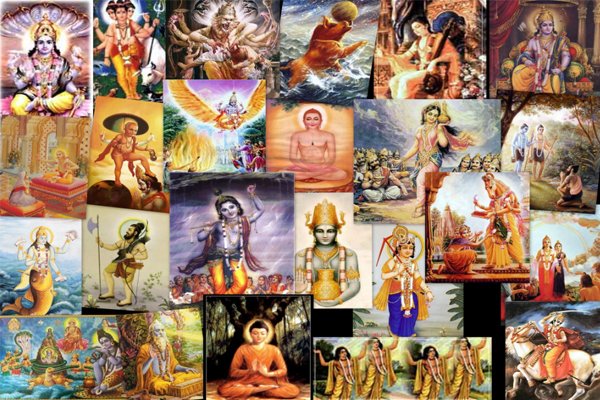
We understood the thought process of our sages behind designing the system of many forms of One God, each of which represents a particular quality or energy of the Supreme Formless God.
Many people attribute its origin to the fact that Hindus worship every element as God and hence they have 33 crore (koti) deities. Some people find it a matter of ridicule and many follow it blindly without knowing its real significance. The word ‘Koti’ in Sanskrit means crore and also means ‘type’. In this word ’33 koti’ means 33 types and not 33 crores. There are 33 types of deities with their own unique qualities and powers. The Taittiriya Upanishad, Chapter 8.1, mentions the fact that there are 33 types of deities.
Brihadaranyaka Upanishad, Chapter 3.9.1 mentions that numbers like 33 crores or 3003 or 303 are wrong. There are 33 types of deities who are the main forms of God. Sage Yajnavalkya has officially said that ‘God is one, but He has many names and forms’. In Durga Saptashati, Chapter 10.4, Goddess Durga also mentions that ‘I am alone in this world, all other forms are my forms’, indicating that God is one.
Similarly, many other scriptures like Atharvaveda, Rigveda etc. clearly mention only 33 types of deities. These 33 types of deities are: eight Vasus, 11 Rudra, 12 Aditya, Indra and Prajapati. Let us tell you their importance.
The eight Vasus represent different aspects of nature, which are Earth, Water, Fire, Air, Sky, Moon, Sun and Star. Vasus means where the living beings live or support life. For example, Earth is home to a vibrant ecosystem and the Sun supports life by providing life force energy. Vasus is the protector of the life cycle in the universe and hence since ancient times we worship the elements of nature as God.
The eleven Rudras are within you, they are the five senses and the five senses (sensory and motivational organs) and one mind. Some people also refer to the 11 Rudras as the 10 Pranas which are the life force energy within us and as the 11th mind.
When one of our organs stops functioning or when our body becomes lifeless at the time of death, it becomes a cause of great sorrow for us and our loved ones. When one of our nails breaks, we also feel pain. Any damage to our body parts becomes the cause of our misery, hence the meaning of name Rudra is anything whose loss can make you cry. Like the heart, eyes, ears or any other organ, cells serve us and their loss causes us great pain. That’s why he is called Rudra.
The twelve Adityas are the twelve months of the year. Aditya is the one who takes everyone along. As the months pass by, a person’s life passes. Time moves on with everyone. Similarly, Aditya also indicates people with great mindset who have conquered time (became timeless), live selflessly and devote all their time to the welfare of the society. Such leaders ensure that everyone associated with them also grows and becomes successful. Therefore, they are like gods in this world.
Indra is the god of energy. Rain, lightning and thunder are powerful forces on this earth controlled by Indra. But, Indra is also the power and power that is hidden in everyone. Those who make full use of this energy become great and lead extraordinary lives. They use this tremendous power to achieve larger than life goals with lightning speed. He also has the power to stand up against the acts of iniquity. Therefore they are gods.
Bhagavad Gita Adhyay 10.41 clearly states that those who are proud, beautiful, powerful and have great recognition in the society, have manifested the divinity of God more. Prajapati is identified with yajna, which does not simply mean offering to the holy fire, it means performing a yajna. Knowingly or unknowingly every living being performs Yagya. Plants release oxygen and absorb carbon dioxide.
Snakes prey on rats and the rat population remains under control. Cow gives us milk which we drink since childhood. Thus, for the proper functioning of the world, every living being is contributing. Man is capable of making the most sacrifices out of all species. Bhagavad Gita Adhyay 3.14-15 states that yagya-bhava or the desire to make selfless sacrifices for others balances the whole of nature. God is present in such acts of sacrifice.
Thus with the concept of 33 categories of deities, our great sages meant that everything we see in the external and internal world with the above qualities are all deities. They are the powers of the Supreme Lord. Hope you now understand the deep significance of 33 koti deities who are manifestations of an infinite, formless God.

